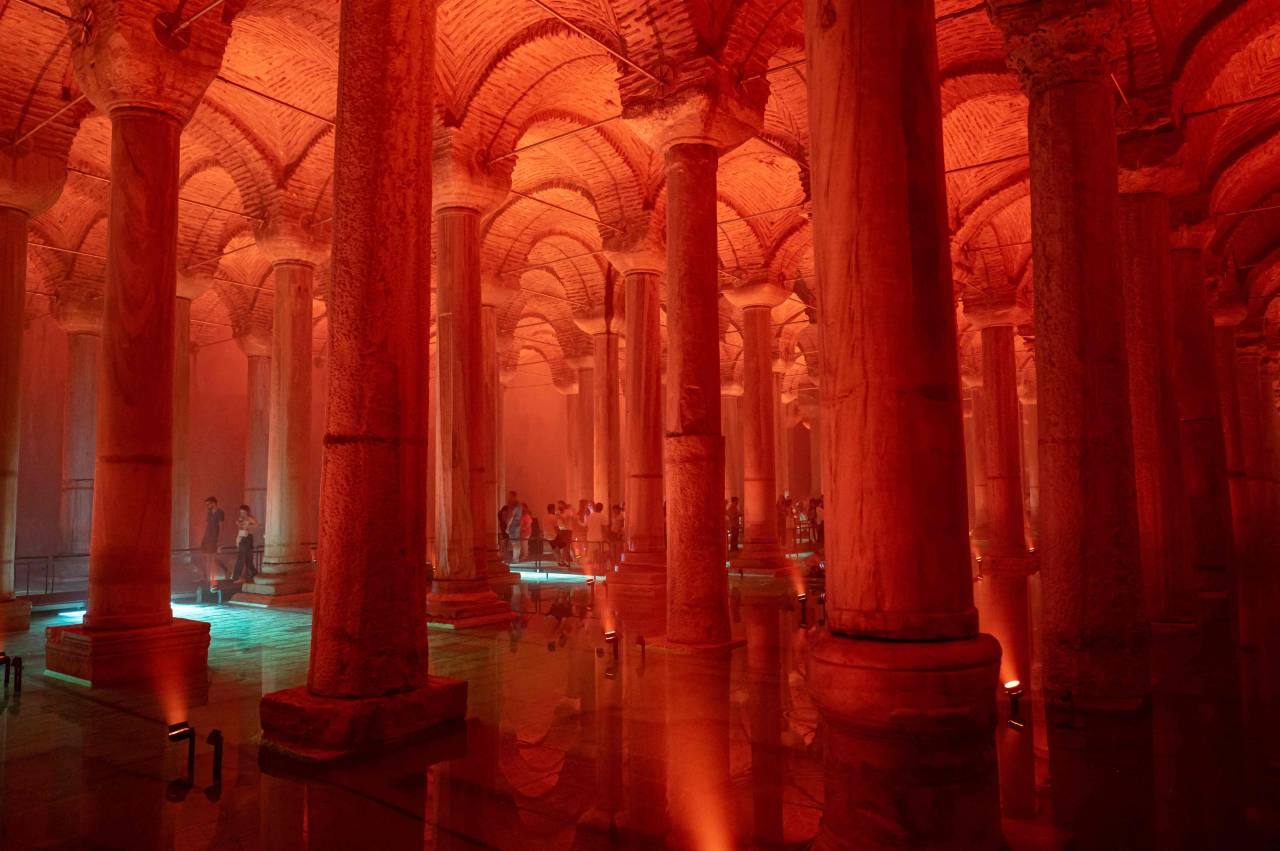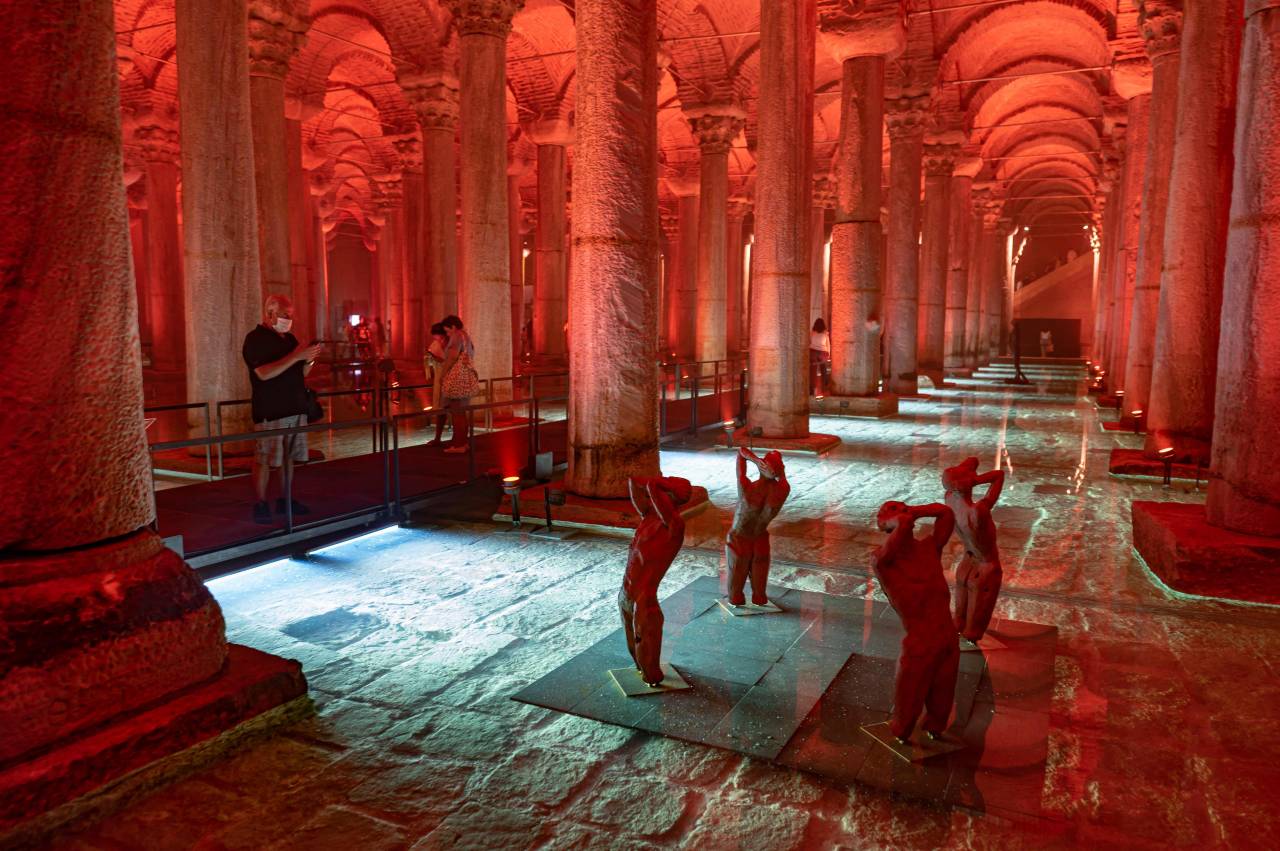We enter with shivers, after the heat of Sultanhamet, to plunge into the mystical freshness of Byzantium: the cistern-basilica of Emperor Justinian, one of the jewels of Istanbul (ex-Constantinople), has just reopened to the public. . After five years of heavy work intended to protect it from the next earthquake, regularly promised to the city, this essential stage in history on the banks of the Bosphorus has been transformed into a spectacular sound and light scene which reveals the immensity of the places (138 m long by 65 m wide).
The cistern-basilica of Emperor Justinian has remained first partially closed since 2017, then completely since the outbreak of Covid-19 in 2020. Yasin Akgul/AFP
Built in the year 542 AD, the cistern-basilica of Emperor Justinian was part of a network of more than a hundred others started by the Romans, continued by the Byzantines and then by the Ottomans to supply running water to the city and their palaces. Known in Istanbul by its Turkish name of Yerebatan Sarnici (the cistern buried underground), the underground basilica which had hosted James Bond (From Russia With Love) threatened to collapse at the slightest violent jolt, explains Aysen Kaya, director Heritage Assistant at Istanbul Municipality. It was therefore urgent to strengthen its infrastructure while cleaning it up.
It has remained first partially closed since 2017, then totally since the outbreak of Covid-19 in 2020. Steel rods have been stretched to connect the capitals of the 336 columns of the building – twelve rows of 28 columns. The pink brick walls have been cleared of traces left by several untimely interventions. “By scraping off the added layers of cement, we brought the bricks up to date”, continues Aysen Kaya, who points out two pipes revealed by the works and hitherto ignored: one brought water to the Basilica of Saint- Sophie very close, the other in the Byzantine palace which preceded the Topkapi of the sultans. The cistern was capable of storing almost 80,000 liters of fresh water arriving from the mountains 19 km to the north. A feat to guarantee Byzantium against summer droughts.
 Built in the year 542 AD, the cistern-basilica of Emperor Justinian was part of a network of more than a hundred others begun by the Romans. Yasin Akgul/AFP
Built in the year 542 AD, the cistern-basilica of Emperor Justinian was part of a network of more than a hundred others begun by the Romans. Yasin Akgul/AFP
Upside down jellyfish
The refurbishment has also made it possible to dismantle the previous walkway fitted out for visitors at 1.60 m above the ground to bring the stroll to less than 50 cm above the pavements, made visible for the first time under the water.
But beyond the technical arrangements necessary to safeguard the building, the renovation endeavored to protect the mystical, almost spiritual character of the places by a play of lights which modifies the perspectives and reveals the details. The famous heads of Medusa that adorn two of the corner pillars – carved upside down so as not to turn the visitor looking at them to stone, according to the legend of Homer’s Odyssey – appear even more vivid and terrifying. And at the heart of this 1,500-year-old construction, representative of the art and techniques of the time, were deposited contemporary works, such as this hand emerging from the water, these jellyfish in translucent glass and these projections of light dancing on the columns. “We wanted a light installation that takes nothing away from the mystical atmosphere of the place”, justifies the representative of the municipality.
To see the success that surrounds this reopening and the long queues under the sun to enter this fitted semi-darkness, the bet is successful. Witness Nick Alatti, a 40-year-old from Birmingham (England) who struggles to find the words to match his enthusiasm: “Absolutely incredible, truly unique. I’ve never seen anything like it and I’m not about to forget it, ”he says.
Anne CHAON/AFP
We enter with shivers, after the heat of Sultanhamet, to plunge into the mystical freshness of Byzantium: the cistern-basilica of Emperor Justinian, one of the jewels of Istanbul (ex-Constantinople), has just reopened to the public. . After five years of heavy work intended to protect it from the next earthquake, regularly promised to the city, this essential stage of…
We would love to give thanks to the writer of this article for this awesome content
Immersed in the mystical freshness of Byzantium
Our social media profiles here and additional related pages here.https://nimblespirit.com/related-pages/

